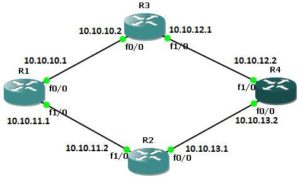 Routers are used to direct data and traffic between two or more networks and essentially, there are two methods of doing so; static routing and dynamic routing. In static routing, a single path is setup by the network administrator whereby traffic and data is transmitted to the intended network. This is done by establishing a routing table in the router.
Routers are used to direct data and traffic between two or more networks and essentially, there are two methods of doing so; static routing and dynamic routing. In static routing, a single path is setup by the network administrator whereby traffic and data is transmitted to the intended network. This is done by establishing a routing table in the router.
However, static routing can sometimes be unreliable because if the link goes down, data cannot be transmitted or received over the network. On the other hand, static routing involves manually creating, maintaining, and updating the router table in the router during link failures. It also includes more overhead for administrators and scaling problems.
Dynamic Routing: How does it Work?
Dynamic routing eliminates such issues by the implementation of certain routing protocols that allow the router to automatically choose the best possible path for data transfer when there are real-time changes in the network layout. It is able to scale better and there’s almost no overhead for network administrators. These protocols were developed by Cisco. They are as follows:
- Routing Information Protocol (RIP)
- Open Shortest Path First (OSPF)
- Enhanced Interior Gateway Routing Protocol (EIGRP)
- Border Gateway Protocol (BGP)
The main purpose of routing protocols is the exchange of data and information between routers. A protocol consists of algorithms, messages, and processes used for exchanging routing information in order to determine the best path. These paths are internet protocol addresses or commonly known as IP addresses. An IP address is a logical address that facilitates the flow of data and information between a source and destination. It is a numerical label that is assigned to every device on the network.
At the basic level, there are two classes of dynamic routing protocols:
- Interior gateway protocol (IGP)
- Exterior gateway protocol (EGP)
In IGP or interior gateway protocol, routers communicate with each other within a single organization or company in an internal network. Examples of IGPs are RIP, EIGRP, and OSPF. In exterior gateway protocol or EGP, routing is established between the different IGPs. An example of EGP is BGP which is the only protocol used for exterior routing.
This is done by setting up autonomous systems; an autonomous system is simple a group of routers communicating with each other in a local setting and under a single administration. Hence, IGPs are applicable within an AS and EGPs are applied between different autonomous systems.
Contrary to popular belief, routing protocols are not only used for exchanging information, but also for the following purposes:
- Remote networks are discovered.
- Routing information is constantly updated.
- Selecting the optimal path to destination networks.
- Searching for an alternative path if the current path fails.
There are 3 main components of a dynamic routing protocol. They are:
- Data Structures:
It refers to databases or tables stored in the RAM of the router.
- Routing Protocol Messages:
Various messages are exchanged between routers for discovering nearby routers, exchange information about routing, and maintaining precise network information.
Algorithms:
It refers to a set of steps used to facilitate routing and determining the optimal path for routing.

